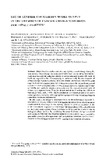Mostrar el registro sencillo del ítem
Use of general circulation model outputt in the creation of climate change scenarios for impact analysis.
| dc.rights.license | http://creativecommons.org/licenses/by-nc-sa/3.0/ve/ | |
| dc.contributor.author | Robock, Alan | |
| dc.contributor.author | Turco, Richard P. | |
| dc.contributor.author | Harwell, Mark A. | |
| dc.contributor.author | Ackerman, Thomas P. | |
| dc.contributor.author | Andressen L., Rigoberto | |
| dc.contributor.author | Chang, Hsin-Shih | |
| dc.contributor.author | Sivakumar, M. V. K. | |
| dc.date.accessioned | 2015-11-09T14:19:52Z | |
| dc.date.available | 2015-11-09T14:19:52Z | |
| dc.date.issued | 1993 | |
| dc.identifier.uri | http://www.saber.ula.ve/handle/123456789/41092 | |
| dc.description.abstract | Many scientific studies warn of a rapid global climate change during the next century. These changes are understood with much less certainty on a regional scale than on a global scale, but effects on ecosystems and society will occur at local and regional scales. Consequently, in order to study the true impacts of climate change, regional scenarios of future climate are needed. One of the most important sources of information for creating scenarios is the output from general circulation models (GCMs) of the climate system. However, current state-of-the- art GCMs are unable to simulate accurately even the current seasonal cycle of climate on a regional basis. Thus the simple technique of adding the difference between 2 x CO 2 and i x CO 2 GCM simulations to current climatic time series cannot produce scenarios with appropriate spatial and temporal details without corrections for model deficiencies. In this study a technique is developed to allow the information from GCM simulations to be used, while accommodating for the deficiencies. GCM output is combined with knowledge of the regional climate to produce scenarios of the equilibrium climate response to a doubling of the atmospheric CO2 concentration for three case study regions, China, Sub-Saharan Africa and Venezuela, for use in biological effects models. By combining the general climate change calculated with several GCMs with the observed patterns of interannual climate variability, reasonable scenarios of temperature and precipitation variations can be created. Generalizations of this procedure to other regions of the world are discussed. | es_VE |
| dc.rights | info:eu-repo/semantics/openAccess | |
| dc.title | Use of general circulation model outputt in the creation of climate change scenarios for impact analysis. | es_VE |
| dc.type | info:eu-repo/semantics/article | |
| dc.description.email | andresen@ula.ve | es_VE |
| dc.publisher.pais | Venezuela | es_VE |
| dc.subject.facultad | Facultad de Ciencias | es_VE |
| dc.subject.institucion | Universidad de Los Andes | es_VE |
| dc.subject.tipo | Artículos | es_VE |
| dc.type.media | Texto | es_VE |
Ficheros en el ítem
Este ítem aparece en la(s) siguiente(s) colección(ones)
-
Articulos, Pre-prints (Facultad de Ciencias)
-
Articulos, Pre-prints (Instituto de Ciencias Ambientales y Ecológicas (ICAE))
Articulos, Pre-prints del Instituto de Ciencias Ambientales y Ecológicas (ICAE)


